

0278-B1
Shu Lifu, Tian Xiaorui and Wang Mingyu[1]
The paper looks at the occurrence of forest fire in China. The country is not rich in natural forest sources. Because of natural and historical factors, forest fires have been long been a problem in China. Forest fire prevention and control are key factors in our ecological plans. Taking China's special geographical location, topography, climate and the distribution of forest sources into consideration, we have every reason to believe that forest fires in China have their own special environment and occurrence. Forest fires arise occasionally from thunderstruck or self-burning peat. However, most fires are caused by human activities, while inappropriately using fires in production and daily life. Since China is located in the northern hemisphere with a vast land area, there is a striking difference in the climate between South China and North China.
China is not rich in forest sources. Its total forest coverage is 158.9 million hectares, 16.552% of the total land; potential timber supply is 11,267 million stere; average forest area and average potential timber supply per head is far below the average level of the world. Such a situation fails to meet the needs of our national economic development; on the other hand, it has a serious effect on the natural conservation and ecological equilibrium. Forest protection work is so intensified; among which forest fire prevention is the most important of all. Forest fire prevention and controlling has long been held as a very important factor in our ecological plans. In May 1987, a conflagration killed 213 persons, burned 1,330.000 hectares (3,286.385 acres) in Daxingan Mountains, in the northeastern part of China, damaging 870.000 hectares (2,149.770 acres) of forest area, 10.081 homes in 3 towns, and much equipment (Fig.1).
Fig.1 Disaster forest fire happened in Daxingan Mountains in May 6,1987
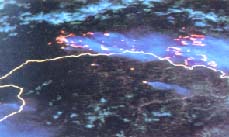

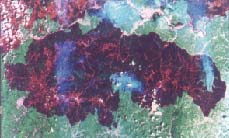
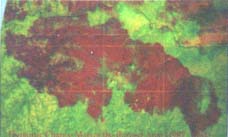
Taking China's special geographical location, topography, climate and the distribution of forest sources into consideration, we have every reason to believe that forest fires in China have their own special aspects.
Owing to natural and historical factors, forest fires have been long frequenting China. Statistics during the years from 1950 to 1999 show that about 670,000 forest fires took place within this period, averaging 14,700 cases per year and 88,4400 hectares of fire-sweeping forest areas every year (0.685% of total forest coverage) (Fig 1). The great Daxinganling fire of May 1987 became a catalyst in the management of forest fires in China and provided many lessons in forest fire awareness and law and law enforcement. Fire prevention technology has been improved, as has the integration of administrative management systems at all levels of government. Form 1988 to 1999, the average area burned by fire has decreased by 94.5 per cent, compared to the 38-year period between 1950 and 1987.
Forest fire losses fall into the following categories (Fig.2):
Man-power and materials, such as food provisions, fire-extinguishers, vehicles; Properties destroyed by the fires, such as buildings, storehouses, waiting-to-be-transported timbers. Forest fires usually spread quickly over a wide area with high intensity. Once a forest fire occurs, hundreds upon thousands of people are usually ordered to participate in fire fighting, since the lack of advanced fire-extinguishing technology and facilities, which in turn results in the waste of manpower and expenditures.
Also a fire down-grades the forest density, damages forest structures and lowers the use value of a forest. Investigations in Heilongjiang Province and Yichun Forest Area show that when a fire sweeps through a conifer tree area of Korean pines and larches or a conifer-broadleaf tree overlapping area, an average of 40% trees die in the mid-age forest; 50%-60% die in the fully-grown forest; almost 100% die in the forest or the afforestated forest with an age of less than 15 years.
Fig.2 Forest Fire Effects on Daxingan Mountains

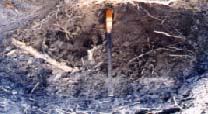
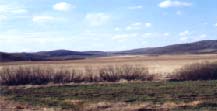

2.3 Damage done to the ecological environment
It affects the replacement of forest plants, forest environment and ecological effect. This surpasses the losses involved in the above-mentioned two kinds of direct losses. It lowers the forest protection on water and soils, losing its function of conserving water sources and regulating climate. As a result, the organic matters in the soils are damaged, surface soils become acidized and crusted losing its ability to reserve water, some lower-land turn into swamps; meadows, terrace land and slopes turn warren, cultivated land shift into grassland with rocks sticking up losing its original productivity. The destructive effect of forest fires on forest is all too easily observed here.
Three aspects of forest fires time are observed: obvious distributions in a day, seasonal change and annual distributions, which have profound influence in China's forest fire prevention: fire control and fire management respectively.
Sunshine affects the specific area climate within 24 hours. With sun rising in the east from 6-10 a.m., air temperature keeps rising, relative humidity drops steadily and wind speed increases; From 10 a.m. to 17 p.m., daily highest temperature, lowest relative humidity and strongest wind speed are reached; Within 17-21 p.m., temperature drops gradually, humidity picks up and wind speed weakens; From 21 p.m. to 6 a.m. next day, low temperature, relative high humidity and low wind speed prevails. The above regular changes have a lot to do with the occurrence of the fires and the result of fire control efforts. Fires break out often between 10 a.m.-21 p.m. and are usually controlled between 21 p.m. and 6 a.m. the next day. In the high and steep mountain areas of southwest China, efforts to control the fire are suggested to be carried out in the early dawn period, since mid-night action might lead to heavy casualties.
Since China is located in the Northern Hemisphere with a vast land, there is a striking difference in the climate between South China and North China. Under the influence of climatic circular movement and monsoon, the most fire-favorable seasonal periods are observed in the forest areas of Northeast China, Inner-Mongolia, North China, Southwest China and Northwest China respectively characterized by either dry weather and constant wind, or rainy and humid weather, or accumulation of snow with low temperature or any other such natural conditions.
In Northeast China and Inner-Mongolia Forest Areas, fires normally don't happen in Summer and in winter, because of high precipitation, humid air in summer and low temperature with accumulation of snow and frozen land in winter. Spring and fall are thus fire-hit time starting from mid-March to mid-June in spring and from mid-September to mid-November in fall. The most frequent forest fire-hit time are May and October.
In South and Southwest forest areas, with the dry and wet two seasons in a year, efforts are stressed only in dry season to prevent forest fires, which is characterized by little rain and dry weather. Winter-Spring fire prevention time is suggested from Mid-November to the end of May in the following year. The most fire-hit time is February, March and April in a year.
In Northwest Forest Area, mainly Xingiang Autonomous Region, with annual low precipitation, drastic warm and cold changes, summer and fall are most fire-hit time when strong monsoon strikes, sandstorm and dry weather occur. Fire-hit time from the end of July to the end of September. The most fire danger time is August and September.
Fig. 3 1950-1998 Forest Fire Distribution
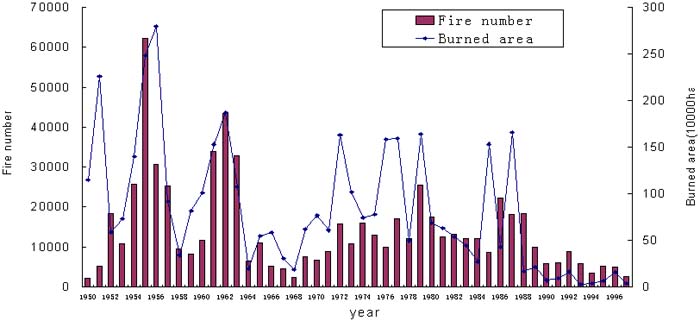
There is a striking difference in the occurrences of fires from year to year with more fires, larger burnt areas and heavier losses in one year while fewer cases; fire burnt areas in the other years. Statistics show(Fig.3) that the year which has undergone more than 15,000 cases of forest fires and fire-sweeping forest area more than 1,500,000 hectares is: 1951, 1955, 1956, 1961, 1962 1972, 1976, 1977, 1979, 1987. The years other than that suffered less forest fires. Certain rules can be drawn from these annual changes, which goes in a circle within 5-6 years or of about 10 years. It is suggested that such different annual forest fire variation have some connection with annual atmospheric movement and climatic changes. A year that suffers a severe drought is mostly attacked by severe forest fires while a year is least prone to fires when there is much precipitation, high humidity. On the other hand, the accumulation of flammable materials in the forest also contributes a lot to the annual variation of forest fires. A forest area with coverage of large quantities of flammable materials mostly easily catches fire in a dry year and causes serious disasters.
China is a country of poor forest sources with unbalance distributions. Under the influence of geographical forest distribution, sociological, natural and climatic conditions, and forest fire distribution are also made uneven. Statistics show that the areas that are most targeted by forest fires and suffer heaviest losses are: Heilongjiang Province, Inner-Mongolia Autonomous Region, Yunnan Province, Guangxi Province, Guizhou Province and Sichuan Province. Even among these areas, forest fires take an uneven distribution, concentrating on 16 major regions covering more than 100 counties.
Fig. 4 Forest Burned Area Distributions in Different Districts in China

4.1 Yunnan Province suffers the most frequent forest fires in China, which makes up 20% of the total average fires in China every year. Coming up next are Guanxi, Fujiang, Hunan, Guangdong, Sichuan, and Jiangxi etc. Forest fires occurred in the above eight provinces makes up more than 80% of the whole country. While forest fires counted in the category of major forest areas, South Forest Area takes up 52% of the total, Southwest Forest Area 37%, Northwest Forest Area 6%, Northeast and Inner-Mongolia Forest Area 4%, other areas 1% of the total.
4.2. Heilongjiang Province suffers the largest fire-sweeping areas in an average year, followed by Inner-Mongolia Autonomous Region, Yunnan Province and Guangxi Province. The fire sweeping forest area of the above four provinces or regions makes up 74% of the total of the nation. Taking an account of fires in Guizhou, Sichuan, Guangdong, Fujian, the fire-sweeping forest areas of these 8 provinces (region) totals up to 90% of that of the nation. It indicates that forest fire occurrences concentrate on the Northeast and Southwest areas while Northeast forest area takes 50% of the total and Southwest 24%.
4.3. Based on the analysis on the annual average fire-sweeping area in a single fire, Inner-Mongolia and Heilongjiang comes on the top list in average fire-sweeping areas in a single fire reaching above 1000 hectares each case. Next comes Tibet Autonomous Region while this figure related to the other provinces (regions) is below that of national average. Statistics according to the annual cases of forest fires which have fire-sweeping areas more than 10,000 hectares show that Guizhou (73 cases) comes on the top list, followed by Yunnan (40.3 cases), Fujian (36.8 cases), Guangxi (36.3 cases), Hunan (24.7 cases), Guangdong (22.1 cases), Zejiang (166.3 cases), Jiangxi (14.6 cases), etc. And the provinces and regions mentioned above are scattered mainly in the low hilly areas in south of Yangtze River (Changjiang).
Forest fires destroy forest resources, put a threat to people's lives and properties and endanger industrial and agricultural production. Based on the fire statistics every year, it is found that forest fires in China are characterized by the following facts: large fire-sweeping areas over a country which is poor in forest resources; high fire frequencies with obvious seasonal variation; frequent forest fires distributed unevenly when South forest area have more fires and Northeast and Inner-Mongolia have lost large forest areas every year by forest fires. Statistics over the past years have shown that China suffers on average 14.000 forest fires annually. Average yearly forest fire damaging rate is 0.685%.
Such meteorological tendencies and characteristics as represented by cold, warm, dry and wet, etc., as a result of climatic changes, have considerable influence on forest fires. This influence includes general situations, average situations and special situations as well. It differs from that of weather conditions, and yet is somewhat related. Climatic changes occur on the ground that meteorological changes arise while weather changes fluctuate on the basis of climatic changes. As mentioned above, forest fires occurrences are characterized by daily change, regional change and seasonal change, and some difference as forest fires year by year as a result of periodical change of climatic conditions. As far as the Northern hemisphere is concerned. In high latitude regions sunshine hours increase greatly when summer comes and forest fires are easily observed in dry weather. A Forest-fire Belt is formed starting from Iceland, skipping over the Scandinavian Peninsula, Ukraine, Siberia, passing the Great Xingan Mountains and Changbai Mountains in China, extending to Korea, Hokkaide in Japan, reaching Canada, the Rockies in U.S.A., closing at California and Washington State. Many a forest fires are reported in dry weather along this belt.
Climatic changes differ greatly between North and South China. The occurrence and spread of forest fires also differ following their respective climatic change patterns to a large extent. In North China high-pressure air and low-pressure air follow a comparative regular pattern as a result of West Wind Belt. Consequently forest fire occurrence has strong coincidence. South China is strongly influenced by sub-tropical high pressure, Jianghuai meterological shear line, tropical and highland's weather patterns, etc., thus having more complicated weather change patterns and making the forest fires characteristics differ more greatly. In a word, the occurrences and spreading of forest fires and their characteristics depend largely not only on such factors as ground surface, temperature, humidity, wind force, wind direction, but also on air masses which causes weather change.
Forest fires arise occasionally from thunderstruck or self-burning of peat. However, most fires are due to man's fault while inappropriately using fires in production and daily life. In Southwest forest areas, the method of setting fire to a certain area of forest to open up new farmland and of burning weeds to make fertilizer has been passed down from generation to generation. Ashes from such man-made fires attribute largely to local fires. In Northeast China, hunter's casual smoking and cooking fires by medical herb pickers or mushroom pickers often cause forest fires. A forest fire is most easily started by such man's casual use of fire in fire-favorable weather. An urgent need is called upon to educate the local people with fire-prevention obligation and to make strict outdoor fire use regulations.
China is a country poor in forest resources and its forest areas are unevenly distributed in the remote areas, and the only existing virgin forest appears largely in the remote or the border line areas with sparse population and inconvenient communication, making it hard to carry out fire prevention work. High mountains and deep valleys are typical of the Southwest forest areas which makes fire extinguishing work even harder, while severe forest fires are easily formed. Also, China has large areas of second-generation forest, which are destroyed over and over again resulting in broken forest areas, uneven density and thick weed growth, making them more flammable.
Fig.5 Forest Fire Seasons in China
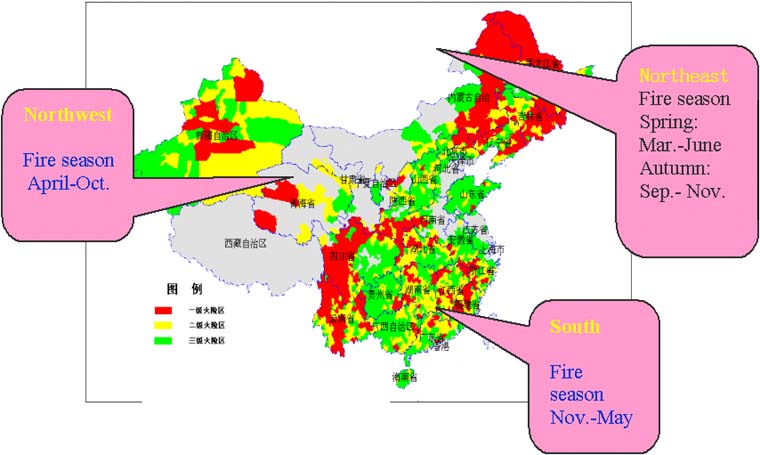
Shu Lifu,Kou Xiaojun.2001. Study of the Pattern of special Forest Fire Behavior by Using Satallite Remote Sensing. Fire Safety Science.10(3):140-144.
Tian Xiaorui,Shu Lifu. 1999.The Development of the Fire Line Research. Fire Safety Science.8(4): 44-49
Shu Lifu, Tian Xiaorui.1999.The development 9 of fire-resistance forest belts research. Scientia Silvae Sinicae.35(4):80-85
Shu Lifu, Tian Xiaorui. 1999.The Studies and Application of Forest Fire Ecology. Forest research.12(4):22-27
Shu Lifu,Tian Xiaorui.1998. The application of prescribed burning. World Forestry Research.(11):93-99
Shu Lifu.1998.Forest Fire.Northeast Forestry University Press, Harbin, P.R.China. pp232.
Shu Lifu.1999.The Theory and Application of Fire-resistant Forest Belts. Northeast Forestry University Press,Harbin,P.R.China.pp265.
Chen Cunji, Shi Xiaofang, Hu Huang et al. 1988. Research on fuelbreaks tree species selection. Journal of Fijian Forestry College. 8(1):1~12.
Gu Fengqi, Wang Shijiang. 1995. Order of combustibility and burning characters of main tree species in Daxing’anling by using Fuzzy. Fire prevention. (2)17~20
| [1] Wildfire Research Group,
Chinese Academy of Forestry, Behind Summer Palace, Beijing, China, 100091.
Tel: +86 10 62889515; Fax: +86 10 62889519; Email: [email protected] |